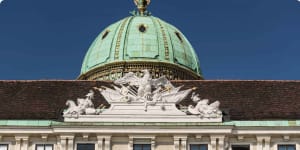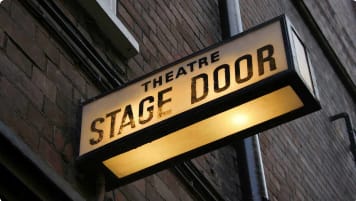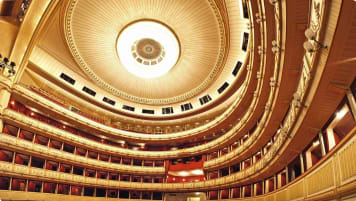Habsburg Art and Classical Music small group Tour
From the mediaeval jewel of Cesky Krumlow to the grandeur of the Habsburg’s summer palace in Vienna, our small group will embark on a 21 night journey to learn about these vibrant and artistically rich cities. We delve into the history of the famous artists, musicians, writers, architects and composers from Austria, Hungary, Poland and the Czech Republic.
From $13,825CAD
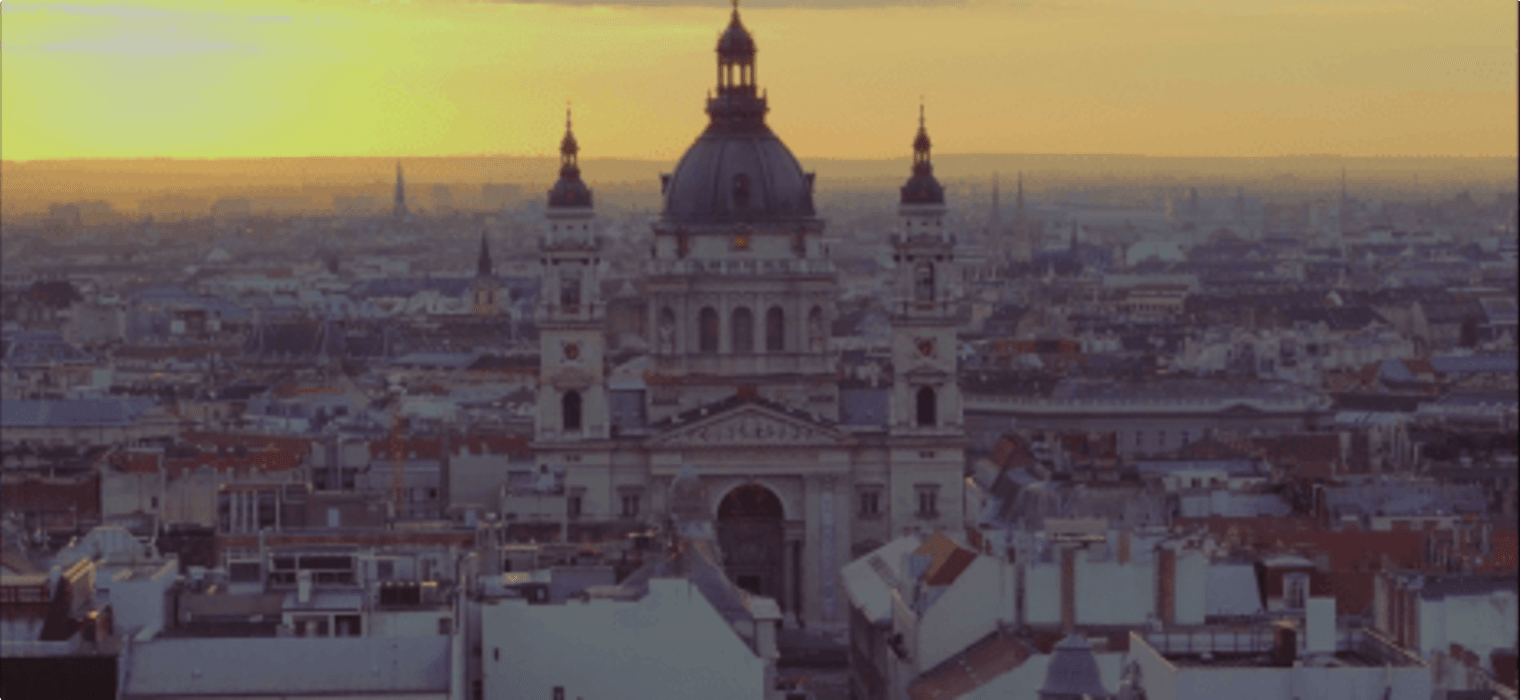
Highlights
- 1. Get a feel of the Cold War when we cross the Charles Bridge, symbol of the era.
- 2. Go underground and tour Krakow’s salt mines, a Jules Verne experience considered the most usual in modern tourism.
- 3. Attend at the Hungarian State Opera a symphony featuring the works of the dynasty’s great composers.
- 4. Explore the Schonbrunn Palace home to the Habsburgs during the height of the dynasty.
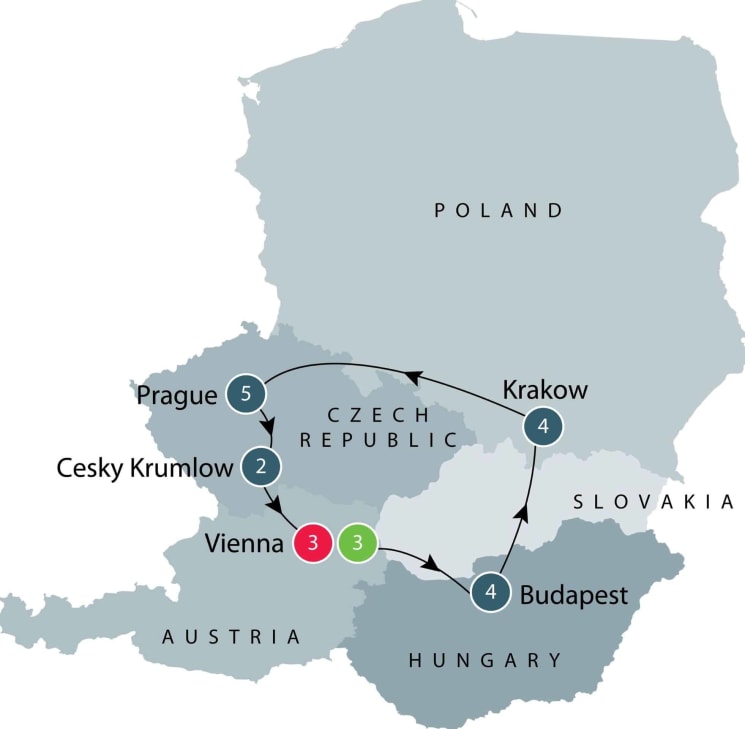
Departure Dates
| Departure Date | Price |
|---|---|
| 25 August 2025 Ends 15 September 2025 • 22 days $14,506 Twin $16,460 Single Available | Selected |
| 24 August 2026 Ends 14 September 2026 • days $14,506 Twin $16,442 Single Available |
Habsburg Tour: The Art and Music explored
From the medieval jewel of Cesky Krumlow to the grandeur of the Habsburg’s summer palace in Vienna, this small group tour takes us on an unforgettable journey to learn about these vibrant and artistically rich cities. We delve into the history of the famous artists, musicians, writers, architects and composers from Austria, Hungary, Poland and the Czech Republic. Over the course of this educational tour, we also attend musical performances in each city and inspect significant art collections. This Habsburg art and music small group tour is for those who love art, architecture and Europe's cultural history.
Vienna
Our small group tour begins in the capital of Austria, Vienna, which has long been an important cultural and artistic centre. The city has attracted musicians from Mozart and Haydn to Strauss. It houses some of the world's great art collections from the old Flemish masters to Klimt and the Expressionists. Here, we experience the city's great artistic and musical culture with a lecture on the History of Music. We enjoy a walking tour of Vienna with a local guide. Here we learn about the environment that gave us its music, those who composed it, and how they lived, all against the dominant background of their relationship with their patrons, the Habsburgs.
While in Vienna, we also see the icons of the city. These include the sights made famous by the city's many composers as well as view its magnificent architecture. There is the imposing Schonbrunn Palace, Stadthof, the Johann Strauss Memorial and St. Stephan's Cathedral in the heart of the old city.
We also visit Zentral Friedhof (the Vienna Central Cemetery) to view the graves of Beethoven and Schubert. The municipality of Vienna expressed gratitude to composers by granting them monumental tombs. Among others buried here are Antonio Salieri (the evil genius of the film Amadeus), Johann Strauss the older, Johannes Brahms and Johann Strauss the younger. In addition, we also view the Vienna State Opera House, dating back to the mid-19th century.
Budapest, Krakow, and Prague
After our time in Vienna, we head to Budapest, with several stops en route. We explore Esztergom, the centre of the Catholic faith in Hungary and the country's medieval capital dominated by a huge Basilica; Visegrad with its Renaissance Palace of King Matthias with superb views over the river; and Szentendre, once a royal stronghold and still a thriving artistic centre where a myriad of galleries and artist shops thrives in the pretty 17th century baroque, rococo and Louis XVI houses. From here, we travel to Krakow, Poland, then Prague and Cesky Krumlow in the Czech Republic. Our escorted tour concludes back in Vienna.
Other highlights of our Habsburg tour
Other highlights of this educational Habsburg art and music tour include the chance to visit the houses of the great composers such as Mozart and Liszt. We'll see their original compositions and musical instruments. We also gain a feel for the Cold War when we cross the Charles Bridge, symbol of the era. And we have the opportunity to go underground and tour Krakow’s salt mines, a Jules Verne experience considered the most usual in modern tourism. This small group tour also features a performance at the Hungarian State Opera, where we hear a symphony featuring the works of the dynasty’s great composers. Finally, we also explore the wonders of Schonbrunn Palace, home to the Habsburgs during the height of the dynasty.
You can learn more about Austria, the Czech Republic, Hungary and Poland with our country profiles where all other tour departures are listed as well.
For more details about this tour, click the ‘Top 5’ or ‘Itinerary’ buttons above! If you’re keen to experience this tour, please call or send an email. Or, to book, simply fill in the form on the right hand side of this page.
Gallery
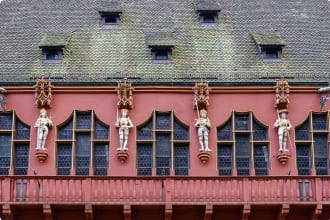


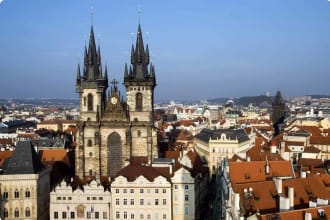
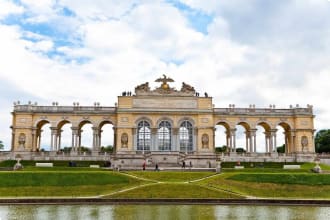
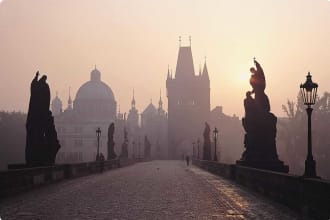
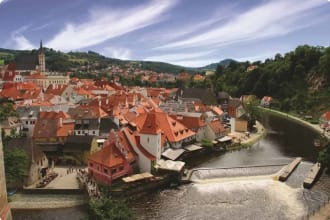

Itinerary
22 days
Day 1: Vienna
Accommodation: Hotel & Palais Strudlhof (or similar).
Arrive Vienna. Transfer to our hotel (own arrangements). There will be some free time before an evening welcome by our local guide followed by a welcome dinner at the hotel.
Day 2: Vienna
Accommodation: Hotel & Palais Strudlhof (or similar).
Vienna has always been a great cultural centre attracting musicians from Mozart and Haydn to Strauss. It houses some of the world’s great art collections from the old Flemish masters to Klimt and the Expressionists.
We experience some of the great artistic and musical culture of the city with a lecture on the History of Music. We tour Vienna with a local guide to learn about the environment which gave us its music, those who composed it, how they lived and against the dominant background of their relationship with their patrons, the Habsburgs.
We see the icons of the city including the sights made famous by the city’s many composers as well as view the imposing Schonbrunn Palace, Stadthof, the Johann Strauss Memorial and St. Stephan’s Cathedral in the heart of the old city.
Visit Zentral Friedhof (the Vienna Central Cemetery) to view the graves of Beethoven and Schubert. The municipality of Vienna expressed gratitude to composers by granting them monumental tombs. Among others buried here are Antonio Salieri (the evil genius of the film Amadeus), Johann Strauss the older, Johannes Brahms and Johann Strauss the younger.
We view the Vienna State Opera House, dating back to the mid 19th century. Tonight we attend a concert by the Vienna Mozart Orchestra at Musikverein.
Day 3: Vienna
Accommodation: Hotel & Palais Strudlhof (or similar).
Today we are joined by our local guide for our journey to the Vienna Woods. For centuries, the Woods have been a rural getaway for the Viennese. This where Mozart, Beethoven and all the other greats of the Habsburg empire would take their relaxation.
Here we also enjoy a guided tour of Heiligenkreuz Abbey followed by a visit to the Carmelite Convent at Mayerling. The Carmelite convent in Mayerling was founded at the behest of Habsburg Emperor Franz Joseph. It was actually a hunting lodge belonging to Crown Prince Rudolf . It was here that an infamous incident took place on January 30 1889, when the prince was found dead with his mistress Baroness Mary Vetsera in an apparent act of suicide. What actually happened has never been satisfactorily explained. Today the lodge is a museum and a tourist attraction and visitors can see the location of the couple’s fateful bed in the convent’s Lady Chapel.
In the afternoon we transfer to Baden, the 2000-year-old Roman spa for our guided walking tour. The town features several Habsburg holiday palaces which we explore on foot.
Day 4: Budapest
Accommodation: Danubius Erzsebet Hotel (or similar).
Today we continue our journey to Budapest with several stops en route: Esztergom, the centre of the Catholic faith in Hungary and the country’s mediaeval capital dominated by a huge Basilica; Visegrad with its Renaissance Palace of King Matthias with superb views over the river; and Szentendre, once a royal stronghold and still a thriving artistic centre where a myriad of galleries and artist shops thrives in the pretty 17th century baroque, rococo and Louis XVI houses.
Day 5: Budapest
Accommodation: Danubius Erzsebet Hotel (or similar).
The city of Budapest has risen from the ruins of World War II and survived the reign of communism to emerge today as one of central Europe’s most forward looking capitals. We explore Budapest which lies in the centre of the Carpathian Basin and is positioned on both sides of the river Danube: Buda on the right, Pest on the left. They were officially joined together in 1873 to form the elegant capital city of Hungary.
This morning we have a tour of Budapest to orient ourselves to its major sites. We have a guided tour of the Hungarian Parliament and visit the Liszt Ferenc Memorial Museum. The Liszt Museum is in fact a reconstruction of Liszt’s last apartment and houses his antique pianos including his renowned Chickering and Bosendorfer pianos.
We have dinner tonight in a local folklore restaurant.
Day 6: Budapest
Accommodation: Danubius Erzsebet Hotel (or similar).
Today we explore the main sights of Buda including a visit to the Hungarian National Gallery. Here we are joined by an English-speaking art historian. The gallery owns more than 6,000 paintings, 2,100 sculptures, 3,100 medallions, 11,000 drawings and 5,000 prints illustrating the development of Hungarian art from the nation’s founding to today.
In the evening we visit the Hungarian State Opera House and take our seats for the evening’s performance. It was completed in 1884 and is Budapest’s and Hungary’s most celebrated performance hall; the Opera House boasts ornate interior featuring frescoes by two of the best-known Hungarian artists of the day, Bertalan Székely and Károly Lotz.
There are dozens of statues of such greats as Beethoven, Mozart, Verdi, Wagner, Smetana, Tchaikovsky and Monteverdi. In corner niches the muses Terpsichore, Erato, Thalia, and Melpomene representing dance, love poetry, comedy and tragedy. It is home to the State Opera and the State Ballet. Well-known directors of the Opera House include Gustav Mahler and Ferenc Erkel, the composer of the Hungarian national anthem. It was founded under the patronage of the Habsburgs. The imperial family, though, was less than impressed by the structure, believing it to be over-ornate.
Day 7: Budapest
Accommodation: Danubius Erzsebet Hotel (or similar).
Today we enjoy a lecture on Hungarian Music & Art by a local specialist. We then visit the spectacular Great Synagogue, on the Pest side, which is the largest synagogue of Europe and the second largest one in the world after the Temple Emanu-El in New York.
This recently restored twin-towered building is 153 years old. A curiosity of the Great Synagogue is an asymmetric configuration in order to place the Ark looking East. Another characteristic is that it is in the Oriental-Byzantine or Moorish style influenced by Muslim architecture. The consecration of the synagogue was a major event on September 6, 1859. It can hold 3,000 seated and approximately 2,000 people standing.
Day 8: Krakow
Accommodation: Hilton Garden Inn Krakow (or similar).
En route to Krakow in Poland we visit Banská Bystrica, 184 km north of Budapest. It has been carefully chosen because of its recent role as a university town since the 1950s. Its largest Matej Bel University was founded in 1992. Many of our party will find it of great interest because its university status post-dates even those of Australasia’s groves of academe considered so modern by the yardstick of the old world.
We continue our journey to the fascinating city of Krakow, with its fine market square and Mediaeval Cloth Hall, is picturesquely set overlooking the River Vistula and has a history reaching back over a thousand years with a whole host of Mediaeval Renaissance and Baroque architecture. This former capital of Poland is often regarded as the looking glass on Polish tradition and is now listed as a UNESCO World Heritage City.
Day 9: Krakow
Accommodation: Hilton Garden Inn Krakow (or similar).
On this, our first morning in Krakow, we meet our local guide who will lead us on a tour to introduce us to the city including the State Rooms, the Cathedral and St Mary’s Basilica, regarded as the most famous of all Poland’s churches.
The 14th-century Wawel Cathedral located inside Wawel Castle in Krakow. It is the spiritual centre of the Polish state and the burial place of national heroes. It was also the cathedral of Pope John Paul II before he left for the Vatican.
In the afternoon we explore Pieskowa Skala, a fairy tale confection that was originally one of the watch towers that protected the region during the mediaeval era. Altered and expanded many times over the centuries, the castle features an imposing gateway and courtyard. Inside there is a permanent exhibition of art and artefacts from the Royal Collection. The rooms follow chronological themes, ranging through Mediaeval, Renaissance and Baroque.
Day 10: Krakow
Accommodation: Hilton Garden Inn Krakow (or similar).
We visit Krakow’s Cloth Hall, the renaissance monument of commerce operating since the 1300s, when a roof was put over two rows of stalls to form the first Sukiennice building – Cloth Hall –home of the textile trade.
Explore the Poland’s oldest museum, the Polish National Gallery with our guide. The Gallery contains the esteemed ‘Gallery of 20th Century Polish Art’ – a highlight of Krakow’s cultural galaxy.
Day 11: Krakow
Accommodation: Hilton Garden Inn Krakow (or similar).
We experience some of the great artistic and musical culture of the city with a lecture on Polish Art & Music.
Then to the salt mines – literally! Krakow’s Wieliczka salt mine, it has been said, compares in structural magnificence to the Egyptian pyramids. This is a Jules Verne-style of subterranean world of labyrinthine passages, giant caverns, and underground lakes with sculptures in the crystalline salt and rich ornamentation carved in the salt rock. The acoustics of the mine have made it, incredibly, a large-scale music auditorium. On the southeast outskirts of Krakow, the mine has been worked for 900 years. It generated much of Poland’s exports in the era when salt, essential to any organic preservation at all, was the mediaeval equivalent of today’s oil. Now though, visitors walk underground for about two km in the oldest part of the salt mine and see one of the world’s most startling mine reconstructions.
Wieliczka contains a total of some 200 km of passages as well as 2,040 caverns of varied size. The route our party will take starts 64 m deep, includes 20 chambers, and ends 135 m below the earth surface down to the museum of mining and its centuries-old equipment and working reconstructions. Chopin is recorded as having been a visitor to the working mine.
This evening we attend a performance of the Polish-born Chopin.
Day 12: Prague
Accommodation: Seven Days Hotel (or similar).
From Krakow to Wroclaw, travelling in our coach south east for 232 km. On the Odra River the pattern of islands and bridges that make up the city often draw forth the description “Venice of Poland”. Free time to explore the market square before transferring to Prague.
Day 13: Prague
Accommodation: Seven Days Hotel (or similar).
An art historian presents a concise outline of Czech art past and present.
Today’s highlights include Prague Castle, also known as Hrdcany Castle, dating back 1,000 years. Then to St. Vitus Cathedral which is the spiritual symbol of the Czech state and a Gothic masterpiece. We explore the National Gallery at the Schwarzenberg Palace with its 160 statues and 280 paintings from the end of the 16th century to the 18th century.
We also visit Strahov Monastery and its library. The current buildings at the Strahov Monastery were constructed during the 17th and 18th centuries. The most interesting parts of the monastery are the Theological Hall and Philosophical Hall. Its collection contains over 200,000 books and includes works from famous printers such as Christoffel Plantin from Antwerp.
Day 14: Prague
Accommodation: Seven Days Hotel (or similar).
This “stone jewel in the Habsburg crown” offers a great wealth of historic and cultural sights from the imposing Castle and mediaeval Golden Lane to the Old Town and famous Wenceslas Square. The city has remained relatively undamaged by the war and, therefore, is today one of the best preserved mediaeval cities, bursting with narrow cobbled streets and ornate baroque facades.
Today we are joined by our local guide for a walking tour of the Old Town and the Lesser Town. Explore Municipal House, Prague’s most noteworthy art nouveau building which features one of the largest concert halls in the city, the Smetana. Municipal House was built in 1911 on the site of the former Royal Court Palace.
Next we visit Wenceslas Square, the crucible of all the nation’s great events including, the Prague Spring and the Velvet Revolution. Cross Charles Bridge, a scene which has featured in many movies about the Cold War. The bridge, crossing the Vltava River is in fact the revered symbol of Prague with its promenade of sculptured saints.
Dinner this evening will be at a celebrated Prague brewery.
Day 15: Prague
Accommodation: Seven Days Hotel (or similar).
Free time today to explore this magnificent city. In the evening we attend a Dvorak concert at the the Prague Rudolfinum Concert Hall. The Rudolfinum was built between 1876-1884 and played an important role in the development of Czechoslovakia, with the seat of the state parliament sited here between the two world wars. Now it is home to the Czech Philharmonic Orchestra, founded in 1896. They perform classical concerts throughout the year in the largest concert hall in the building, the Dvorák Hall.
Day 16: Prague
Accommodation: Hotel Zlaty Andel (or similar).
We are introduced to the musical culture of the city with lectures on Czech Music.
Our visits today include the The Smetana Museum. Here we view Smetana’s greatest compositions along with his documents, and personal effects. The Dvorak Museum housed in an elegant early 18th century baroque summer palace. The Mozart Museum at the Villa Bertramka. The world´s most famous composer Wolfgang Amadeus Mozart visited Prague many times and Villa Bertramka was the place, where he used to stay. It is now the Mozart museum, where you can see many of his manuscripts, documents and the musical instruments he used to play.
We also visit St Nicholas Church in Lesser Town. St. Nicholas Church at the Lesser Town Square is the most important High Baroque building in Prague. The impressive cupola is more than 70 metres high and the nave of the church has a ceiling with one of the largest frescoes in Europe, painted on an area of 1,500 square metres.
Tonight we attend the opera at Estates Theatre, one of the most beautiful historic theatre buildings in Europe.
Day 17: Český Krumlov
Accommodation: Hotel Zlaty Andel (or similar).
Today we leave Prague and head for the UNESCO World Heritage-listed splendour of Český Krumlov. En route to we visit Karlstejn and its castle founded in 1348. The castle was built by Czech King and Roman Emperor Charles IV as a place for safekeeping of the royal treasures, considered the most remarkable of Czech castles.
Day 18: Český Krumlov
Accommodation: Hotel Zlaty Andel (or similar).
This small town in Southern Bohemia is a mediaeval gem and is recognised by UNESCO as outstandingly well preserved. It is a typical red-roofed town, with an impressive Castle complex overlooking the Vltava, and a unique example of mediaeval architecture.
We experience the great mediaeval architecture of this small town with a guided walking tour of its historic streets, monuments and icons.
Day 19: Vienna
Accommodation: Hotel & Palais Strudlhof (or similar).
Our guided tour of Český Krumlov Castle with its forty buildings and palaces, situated around five castle courts and a castle park spanning an area of seven hectares. The groundplan layout of Český Krumlov Castle is one of the largest in central Europe.
Board our coach to return to Vienna where we enjoy the picturesque UNESCO-listed cultural landscapes of the Wachau Valley, stretching the Danube Valley between Melk and Krems.
Day 20: Vienna
Accommodation: Hotel & Palais Strudlhof (or similar).
We experience some of the great artistic and musical culture of the city with a lecture at our hotel. We continue the theme of our lectures with a visit to the Austrian Gallery of the Belvedere for examples of Klimt and the Expressionists.
There will be some time at leisure before we transfer to Neustift am Walde where we will have dinner at a local restaurant.
Day 21: Vienna
Accommodation: Hotel & Palais Strudlhof (or similar).
Today, with our local guide we enjoy a grand tour of the Schönbrunn Palace, Austria’s most-visited cultural attraction. This was for centuries the home and headquarters of the Habsburg Monarchy and it was from here that they controlled an empire spreading from Hungary to the Americas. They were patrons of art in all its forms beyond the previous ecclesiastical restraints and thus they helped usher in the age of the great composers. This Baroque synthesis of different arts, consisting of a palace and gardens, and is today
largely still in its original historical condition. Its 1,441 rooms are authentically furnished.
This evening’s farewell dinner will be held in Palais Liechtenstein.
Day 22: Vienna
Our tour concludes today after breakfast.
Tour Notes
- Itineraries may change if flight schedules, site availability, and other inclusions have to be amended prior to departure.
Includes / Excludes
What’s included in our Tour
- 21 nights hotel accommodation.
- 21 breakfasts, 1 lunches & 8 dinners.
- All excursions, entrance fees and local guides.
- Tickets to all performances.
- Services of Tour Leader for the duration of tour.
- Transport in comfortable and modern coaches.
- Gratuities and necessary tips.
What’s not included in our Tour
- International airfares and departure taxes.
- Comprehensive travel insurance.
- Items of a personal nature such as telephone calls and laundry.
Participants must be able to carry their own luggage, climb and descend stairs, moderate walking on uneven surfaces between 3 - 5 kilometers per day. Suitable for most fitness levels
Book now
Make it a private tour
Easing your journey
Crossing international borders with restrictions
The list of requirements to travel internationally has changed and will continue to change for several years. Odyssey is here to assist you in managing your way through these requirements:
For more information see our Crossing international borders with restrictions page.
Book With Confidence
If less than 30 days before your tour starts you are unable to travel as a result of Government travel restrictions, Odyssey Traveller will assist you with a date change, provide you with a credit or process a refund for your booking less any non-recoverable costs.
See Terms and conditions for details.
Peace of Mind Travel
The safety of our travellers, tour leader, local guide and support staff has always been our top priority and with the new guidelines for public health and safety for keeping safe for destinations around the world, we’ve developed our plan to give you peace of mind when travelling with us.
See Peace of Mind Travel for details.
Reading List Download PDF
The Habsburg Empire: A Very Short Introduction
Martyn Rady
The Habsburgs are the most famous dynasty in continental Europe. From the thirteenth to the twentieth centuries, they ruled much of Central Europe, and for two centuries were also rulers of Spain. Through the Spanish connection, they acquired lands around the Mediterranean and a chunk of the New World, spreading eastwards to include the Philippines. Reaching from South-East Asia to what is now Ukraine, the Habsburg Empire was truly global.
In this Very Short Introduction Martin Rady looks at the history of the Habsburgs, from their tenth-century origins in Switzerland, to the dissolution of the Habsburg Empire in 1918. He introduces the pantheon of Habsburg rulers, which included adventurers, lunatics, and at least one monarch who was so malformed that his true portrait could never be exhibited. He also discusses the lands and kingdoms that made up the Habsburg Empire, and the decisive moments that shaped their history. Dynasty, Europe, global power, and the idea of the multi-national state all converge on the history of the Habsburg Empire. Martin Rady shows how.
ABOUT THE SERIES: The Very Short Introductions series from Oxford University Press contains hundreds of titles in almost every subject area. These pocket-sized books are the perfect way to get ahead in a new subject quickly. Our expert authors combine facts, analysis, perspective, new ideas, and enthusiasm to make interesting and challenging topics highly readable.
The Habsburgs: Dynasty, Culture and Politics
Paula Sutter Fichtner
The death of Archduke Franz Ferdinand in Sarajevo in 1914 not only sparked the beginning of World War I―it also initiated the beginning of the end of the six-hundred-year-old Habsburg dynasty, which fell apart when the war ended, changing Europe forever. But how did the Habsburgs come to play such a decisive role in the fate of the continent? Paula Sutter Fichtner seeks to answer this question in this comprehensive account of the longest-lived European empire.
Tracing the origins of the house of Habsburg to the tenth century, Fichtner identifies the principal characters in the story and explores how they were able to hold together such a culturally diverse and multiethnic state for so many centuries. She takes account of the intertwining of culture, politics, and society, revealing the strategies that enabled the dynasty’s extraordinarily long life: its dazzling mix of cultural propaganda, public performances, and cunning political maneuvering. She points out the irony that one of the crowd-pleasing performances that had enabled the Habsburg success―visiting beds of the injured―led to Ferdinand’s death and the empire’s downfall. Breathing fresh life into the history of the Habsburg reign, this accessible and authoritative history charts one of the pivotal foundation stories of modern Europe.
A History of the Habsburg Empire, 1526-1918
Robert A. Kann
"An impressive achievement in a task of extraordinary difficulty...The outstanding asset of this work does not consist in in its comprehensiveness and objectivity, however, nor even in the wide knowledge and special expertise Kann can bring to bear from his early legal training, his formidable scholarship on the nationalities question, and his keen critical appreciation of the diverse cultures of the monarchy. Its greatest merit derives from the author's determination always to ask fundamental questions, his care to discriminate between surface phenomena and deeper causes, his skill in finding significant patterns in an apparently chaotic welter of events, his facility for perceptive and penetrating distinctions and generalizations. In short, he tried with considerable success to tell what really happened in history rather than simply what obviously happened."―Canadian Historical Review
Habsburg Splendor: Masterpieces from Vienna's Imperial Collections at the Kunsthistorisches Museum
Monica Kurzel-Runtscheiner (Editor), Franz Pichorner (Contributor), Stefan Krause (Contributor)
This beautiful book tells the fascinating story of the Habsburg dynasty, which ruled most of central Europe, Spain, Belgium, and parts of Italy for nearly 600 years, from the 15th through the 20th century. Charles V (1500–1558) once remarked that the sun never set on the Habsburg Empire, and for most of its history, Vienna served as its capital. The Habsburgs were acclaimed collectors and generous patrons of the arts. Franz Joseph I (1830–1916), the penultimate emperor of the dynasty, created the Kunsthistorisches Museum in Vienna to house the artistic treasures of the empire. Today, this museum possesses one of the most renowned collections in the world of Western art. An extraordinarily wide-ranging survey of the Habsburgs’ collections, this volume features classical Greek and Roman works, medieval arms and armor, tapestries, early modern painting and craftwork, ceremonial gilded carriages, and opulent costumes. Together, they reveal the splendor and the spectacle of the Habsburg court.
The Habsburg Empire: A New History
Pieter M. Judson
This panoramic reappraisal shows why the Habsburg Empire mattered for so long to so many Central Europeans across divides of language, religion, and region. Pieter Judson shows that creative government—and intractable problems the far-flung empire could not solve—left an enduring imprint on successor states. Its lessons are no less important today.
The Grand Strategy of the Habsburg Empire
A. Wess Mitchell
The Habsburg Empire’s grand strategy for outmaneuvering and outlasting stronger rivals in a complicated geopolitical world
The Empire of Habsburg Austria faced more enemies than any other European great power. Flanked on four sides by rivals, it possessed few of the advantages that explain successful empires. Its army was not renowned for offensive prowess, its finances were often shaky, and its populace was fragmented into more than a dozen ethnicities. Yet somehow Austria endured, outlasting Ottoman sieges, Frederick the Great, and Napoleon. The Grand Strategy of the Habsburg Empire tells the story of how this cash-strapped, polyglot empire survived for centuries in Europe's most dangerous neighborhood without succumbing to the pressures of multisided warfare.
Taking readers from the War of the Spanish Succession in the early 1700s to the Austro-Prussian War of 1866, A. Wess Mitchell argues that the Habsburgs succeeded not through offensive military power or great wealth but by developing strategies that manipulated the element of time in geopolitical competition. Unable to fight all their enemies at once, the Habsburgs learned to use the limited tools at their disposal―terrain, technology, and treaty allies―to sequence and stagger their conflicts, drive down the costs of empire, and concentrate scarce resources against the greatest threat of the moment. Rarely holding a grudge after war, they played the "long game" in geopolitics, corralling friend and foe alike into voluntarily managing the empire's lengthy frontiers and extending a benign hegemony across the turbulent lands of middle Europe.
A study in adaptive statecraft, The Grand Strategy of the Habsburg Empire offers lessons on how to navigate a messy geopolitical map, stand firm without the advantage of military predominance, and prevail against multiple rivals.
